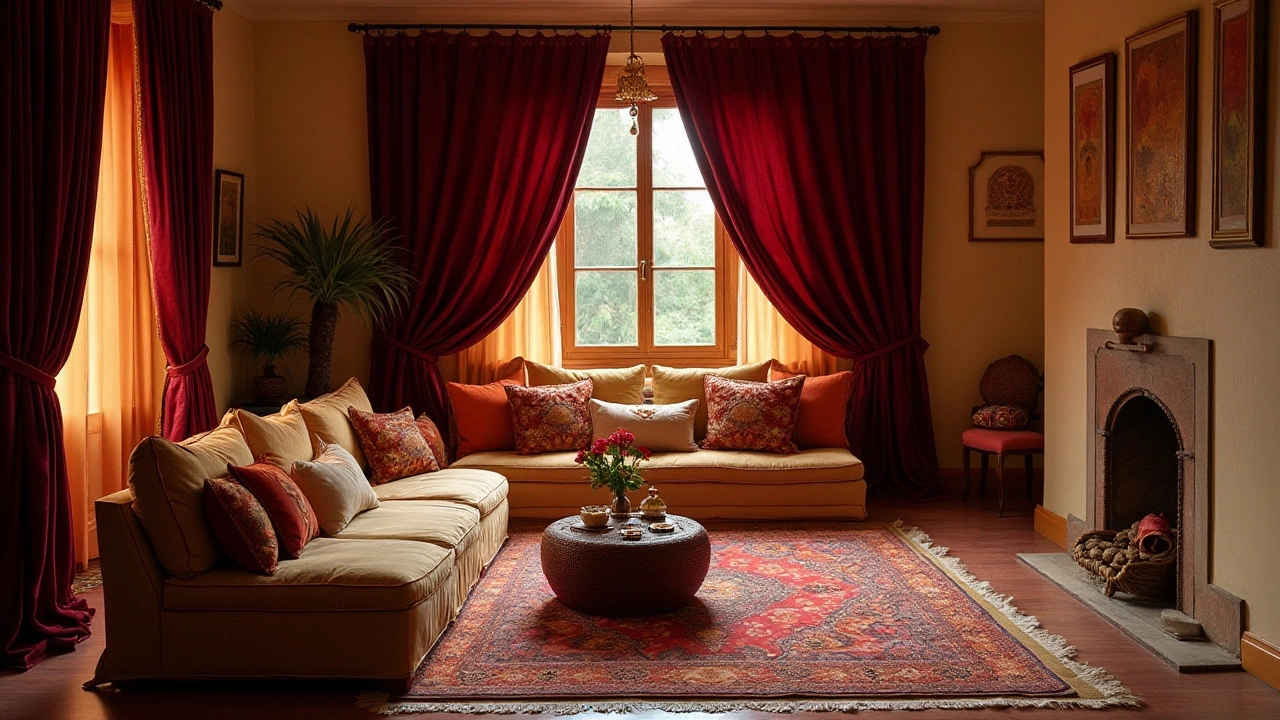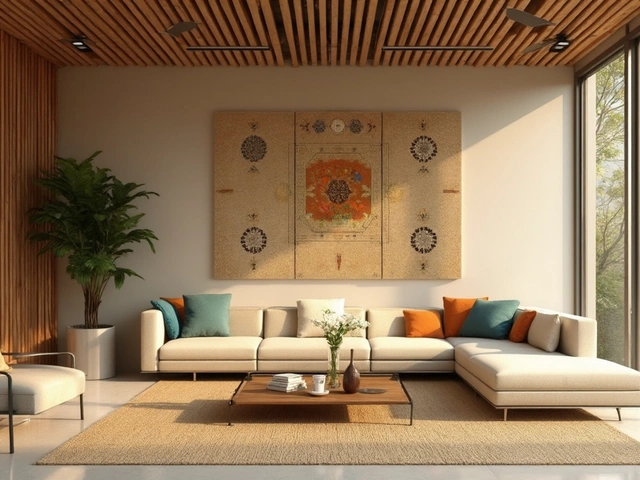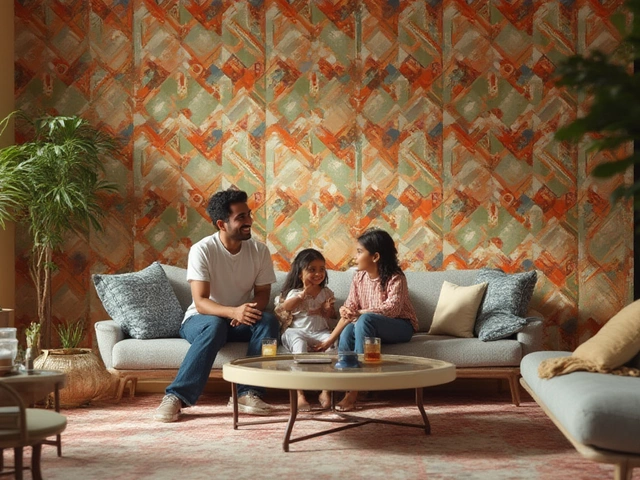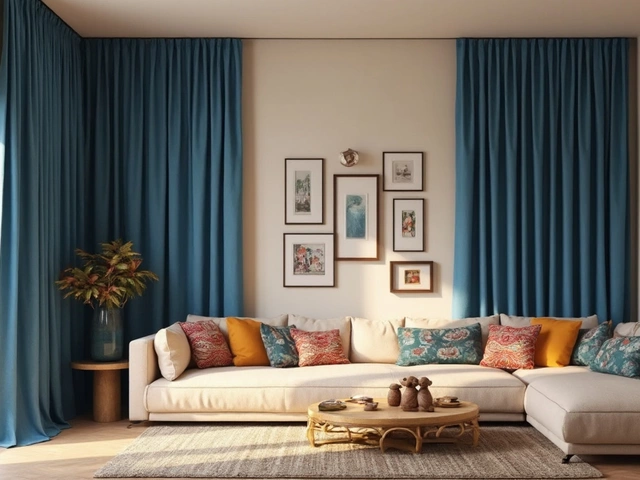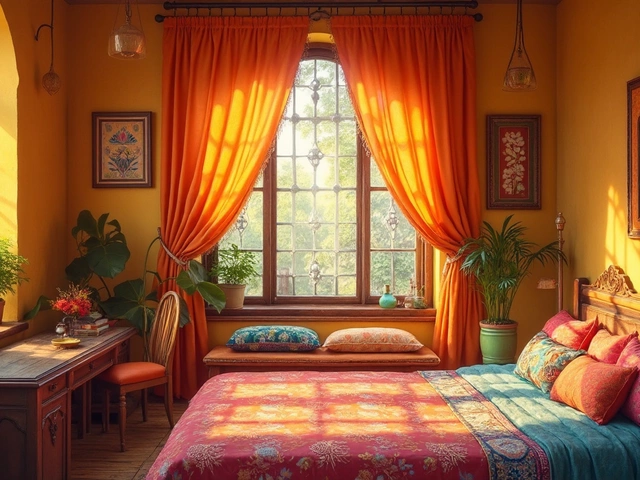The question of whether curtains should be darker or lighter than your walls is more than a simple design decision—it’s about shaping the atmosphere of your room. Curtains hold the power to transform a space, either blending seamlessly with existing decor or making a bold statement.
Getting the balance right involves more than knowing your favorite color. It’s about understanding the interplay between lighting, color schemes, and personal style. This journey uncovers how curtain colors affect room mood, the perception of space, and overall visual harmony.
Join us as we delve into the enchanting world of curtain choices and how they redefine your room’s entire look and feel. From exploring natural light’s influence to simple design tips, learn how to make the best decision for your unique living space.
- Understanding Room Aesthetics
- Impact of Curtain Colors on Mood
- Light vs Dark: Optical Illusions
- Influence of Natural Light
- Design Tips for Matching Walls
- Personalizing Your Space
Understanding Room Aesthetics
Stepping into a room is like walking into a narrative told through colors, textures, and layouts. When considering curtain color, the backdrop, which is your wall, plays a pivotal role in sculpting this narrative. To truly appreciate the impact, first, one must understand room aesthetics - the art and science of creating spaces that are both functional and visually pleasing. Visual harmony in a room arises when various elements like furniture, wall color, curtains, and decor items sync seamlessly, creating a balanced atmosphere. It's not merely about filling a room with beautiful objects, but about orchestrating a symphony that evokes emotion and purpose.
Color, in particular, has an immense influence on aesthetics, and it’s an element that can drastically change the mood. Lighter colors tend to make a space feel airy and expansive, perfect for smaller rooms where you want to maximize the sense of space. On the other hand, darker tones can bring an intimate, cozy feeling to larger rooms or places where you desire a more enclosed atmosphere. Your choice of curtain color should therefore consider these effects while also reflecting your personal taste. Remember the insightful words of iconic designer Albert Hadley, who said,
"Design is defined by light and shade, and appropriate lighting is enormously important."His insights remind us how crucial curtain choices are in controlling light and modifying the perception of space.
For those striving to synchronize their home decor with trending styles, recognizing the role of lighting within room aesthetics is vital. Natural light, along with artificial sources, affects how colors are perceived. For instance, north-facing rooms receive cooler light, which can make colors appear more subdued, optimizing the room for bold, vibrant curtain designs. Meanwhile, south-facing rooms bathe in warm, bright light, making lighter curtains appear ethereal while dimming strong hues. Such insights highlight why a nuanced approach to selecting curtain color in alignment with your walls is critical. The union of curtains and walls, when executed adeptly, crafts a milieu that beckons both tranquility and joy.
Another aspect leveraged by savvy designers involves playing with room aesthetics to manipulate depth and focus. By using contrasting curtain colors against your wall, you can create focal points that draw visitors' eyes around the space, emphasizing particular areas or features like a fireplace or a gallery wall. Conversely, choosing similar tones for both curtains and walls allows the possibility to blur boundaries, a technique particularly beneficial for achieving a minimalistic or modern look. Diving into the principles of design elements, one must consider that texture and pattern also add layers to room aesthetics. Curtains aren’t just about color; they also speak through materials and patterns that either complement or contrast with the existing decor, adding depth and character.
In essence, understanding room aesthetics as you ponder over the curtain dilemma means realizing that every design decision contributes to a grand tapestry. Selecting between lighter or darker curtains isn’t merely a style choice; it’s an opportunity to express identity, reform lighting dynamics, and, importantly, shift how the space feels. Whether you wish to conjure a soothing retreat or a bold, expressive stage, the harmony between your walls and curtain colors remains a paramount pillar in the elegant dance of room design.
Impact of Curtain Colors on Mood
The colors that envelop us within our homes undeniably shape our emotional responses, influencing how we feel as we move through each room. Curtain color plays a pivotal role in this sensory experience. When selecting curtains, one should consider not only aesthetic appeal but also the psychological ramifications of color. Darker hues such as deep blues, purples, and burgundies often create a sense of coziness and warmth. These tones can make a room feel more intimate, much like how a soft, plush blanket offers comfort on a chilly day. The cocooning effect often instills a feeling of security, making them a popular choice for bedrooms and reading nooks, where tranquility is desired.
Conversely, lighter curtains such as whites, creams, and pastels often convey openness and airiness. They are known to enhance the natural light that floods into a room, which can boost mood and energy levels. It's not uncommon for people to associate light colors with purity and rejuvenation, akin to the freshness of a morning breeze. This makes them ideal for spaces where motivation and positivity are key, like home offices or kitchens. A light-infused room not only brightens the physical surroundings but lifts the spirits within them as well.
Eye-tracking studies conducted in interior settings have demonstrated that lighter curtains can make a room appear larger by drawing the eye toward the windows and beyond, creating the illusion of extended space. On the other hand, darker curtains often anchor a room, thereby reducing visual clutter and encouraging a sense of enclosure and peace. Some experts in interior design even suggest that our color preferences in decor are reflective of our psychological states. A predilection for dark curtains might symbolize a desire for solitude and reflection, whereas a favor for light curtains might indicate an enjoyment of openness and social interaction.
"The relationship we have with color in our environment is intrinsically tied to our physical and emotional well-being," remarks Dr. Samantha Reynolds, a leading expert in environmental psychology. "Curtains, serving as both a functional and decorative element, have a profound impact on the mood of any given space."
As with many aspects of home decor, the choice between light and dark curtains should harmonize with the personal style and needs of those living there. It's also important to consider the changing dynamics of a space as the days and seasons alter. Perhaps in a region where the winter months bring early sunsets and lengthy nights, lighter curtains could ensure the spirit of a room remains vibrant throughout the year. Similarly, in sun-drenched locales, darker curtains might shelter an oasis of cool calm from the persistent brightness outside.
For those on the fence about their illustrious curtain journey, a practical experiment could involve temporarily trying one set of curtains and noting any shifts in mood or feelings throughout the weeks. This lived experience could guide the final decision on whether to bathe the space in lightness or wrap it in the comforting grasp of darkness, ultimately leading to a personalized and balanced environment where both form and function find sweet harmony.
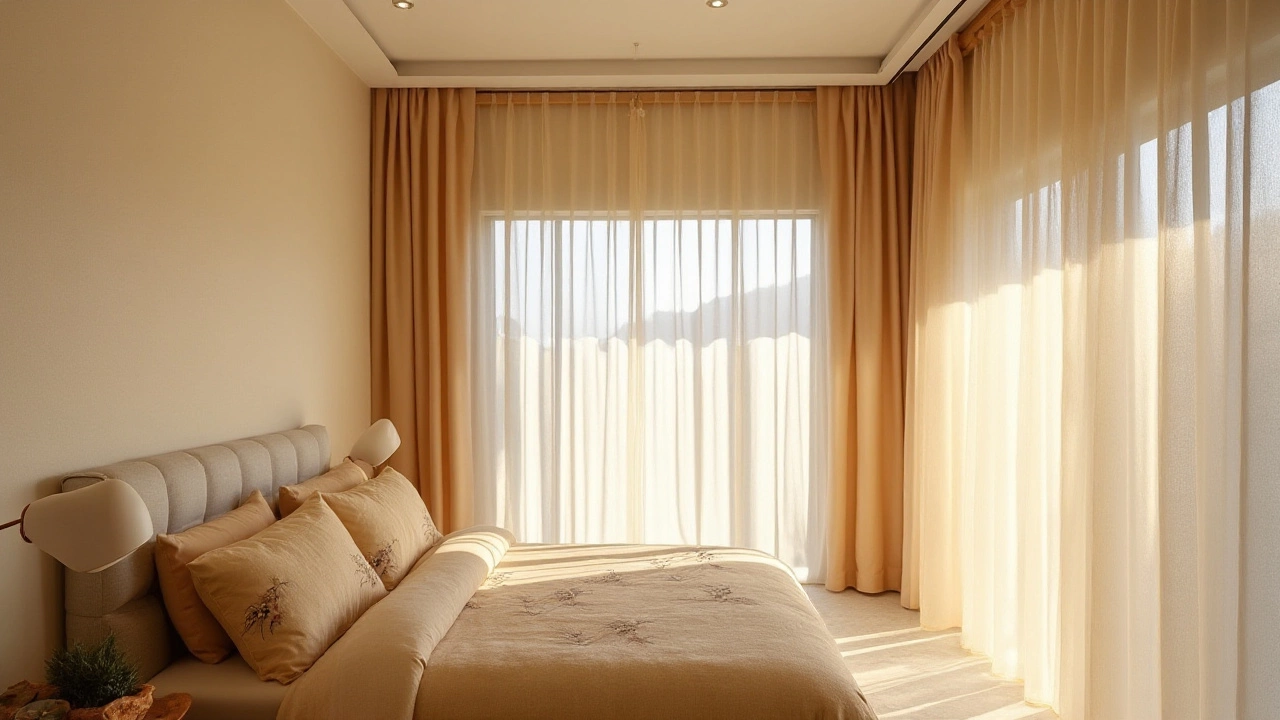
Light vs Dark: Optical Illusions
When it comes to making a room appear larger or cozier, the colors of your curtain color play a significant role in creating optical illusions. Lighter curtains typically lend a sense of openness and airy freedom to a space. This is because they reflect more light, which can make a room feel spacious and bright even if it's not particularly large. Rooms with lighter walls might feel even more expansive when paired with sheer or soft-toned curtains. On the other hand, darker curtains absorb light, creating a more intimate and cozy atmosphere. This is perfect for larger rooms where a touch of warmth is needed to avoid feeling too voluminous or sparse. Such choices can be used strategically to manipulate the visual dimensions of a room to better meet your decorative ambitions.
Consider the psychological effects of colors. Light colors generally invoke feelings of peace and serenity, helping enhance an uncluttered and minimalist look. They can evoke the tranquil beauty of a cloudless sky or the gentle flow of soft sands, acting almost as blank canvases that highlight intricate decor details without competing for attention. Dark colors, conversely, can conjure a comforting shelter from the bustling world outside your windows. They bring to mind the nurturing, enveloping ambiance of a starry night or a warm, inviting den. Each choice speaks to different emotional preferences and lifestyles, offering a chance to design a space that resonates personally.
The interaction between curtain and wall colors also presents unique opportunities for accentuation or blending within your interior design. For instance, if you have a bold and dramatic wall color, lighter curtains might complement by adding contrast, highlighting the striking architecture and decor of your room. Alternatively, matching the curtain to the wall color can blend them seamlessly, offering an understated elegance that doesn't crowd the space with too many visual distractions. Dark on dark can be luscious, providing a monochrome richness that feels deep and intentional, reminiscent of high-end boutique hotels or classic home libraries. In contrast, light on light suggests a sunlit, breezy vibe that's perfect for rooms designed to be uplifting and refreshing.
As with any design choice, personal preference and the room's intended function should guide your decisions. Delve into the interplay of colors, furniture, and natural elements to create a cherished and unified space. As interior designer Sophie Robinson once remarked in an interview,
"Color is a powerful tool in the design toolkit; it can transform not only the energy of a space but also how we feel in it."It's essential to recognize that what feels uplifting in a living room may not suit a private space like a bedroom, where one might seek respite from the day's chaos instead. Thus, the perfect pairing of curtain and wall color hinges on a harmonious blend of aesthetics and functionality.
Influence of Natural Light
Natural light plays a pivotal role in determining the best curtain color for your home. It’s a silent companion that changes the mood and visual essence of a room from dawn till dusk. Depending on the amount and angle of sunlight your room receives throughout the day, the choice between darker and lighter curtains can significantly alter the ambiance. Bright sunshine streaming through a window can illuminate your space, making lighter curtains almost glow and create an airy feel, whereas darker curtains might provide a rich contrast, lending a cozy, comforting atmosphere. Understanding this relationship helps harness natural light to its full potential, making it possible to create inviting, dynamic environments.
In rooms bathed in sunlight, lighter or sheer curtains often outshine their darker counterparts by allowing a soft luminosity that enhances the space. This opens up rooms, giving them a feeling of weightlessness and expansive openness. However, in spaces where sunlight is scarce, darker curtains can compensate by providing a sense of presence and warmth. This is especially beneficial during the cool, darker months when any added layer of texture and color can make a significant difference in home comfort. An interesting study observed that rooms with significant natural light exposure combined with lighter curtains often reported a higher level of perceived happiness and positivity among occupants, particularly in comparison to those with darker curtains.
With regard to considering curtain color, it’s also crucial to acknowledge the role of external views. Windows overlooking lush greenery or vibrant cityscapes can benefit from lighter curtains that frame the scenery rather than obscure it. Alternatively, darker curtains are valuable in situations where you wish to block out less desirable views or reduce excess outdoor illumination. In either instance, various fabric choices affect how the curtains interact with natural light. Materials like silk or linen can add layers to the way light is diffused, offering either a natural shimmer or a muted, matte look.
"Curtains act as both a background and a focus of living areas in the interplay of sunlight and shade, dictating the ambiance," says renowned interior designer Sarah Livingston. Her experiences suggest, "Choosing curtains that complement your room’s light patterns allows for a more cohesive and enjoyable living space."
For more tailored lighting control, double curtain rods or layering with blinds or shutters can help adapt to varying light levels throughout the year. This flexibility is key in transitional spaces like living rooms or home offices, where lighting needs often change. Whether you prefer a subtle backdrop from lighter tones or a striking statement from darker hues, the consideration of your room’s exposure to natural light should guide your decision in creating balanced aesthetics.
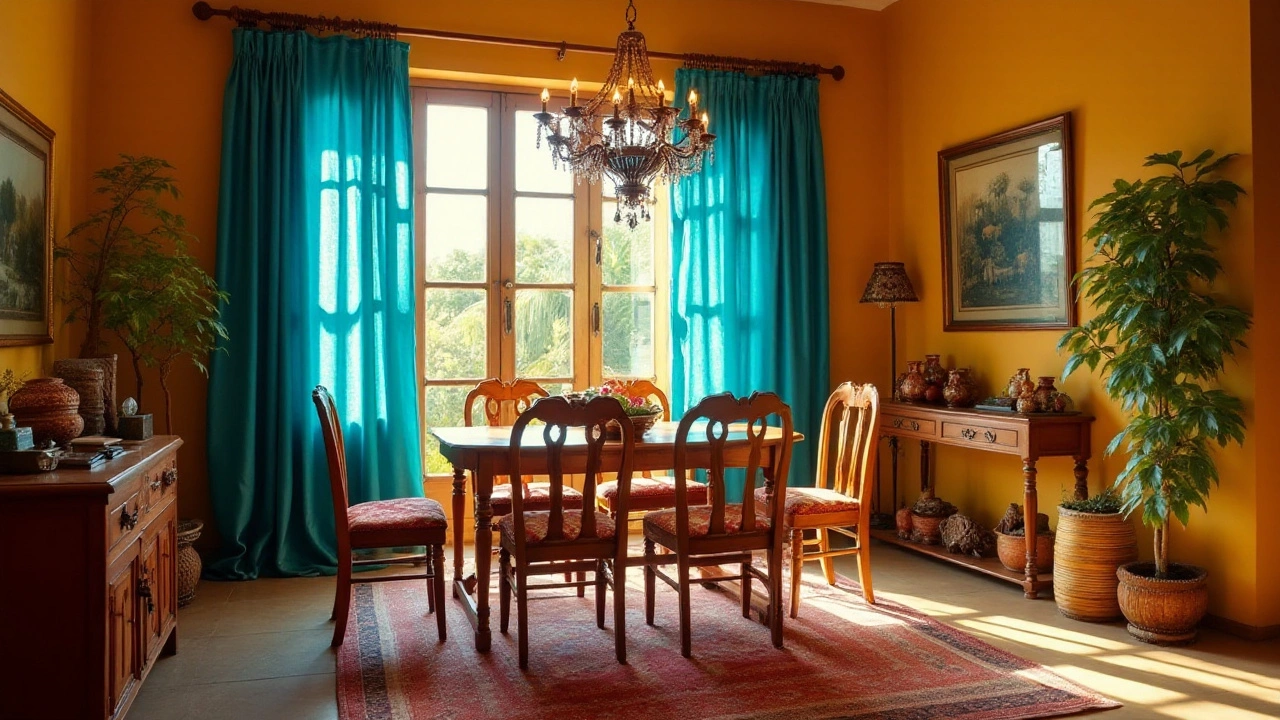
Design Tips for Matching Walls
Choosing the right curtains to match your walls is an art, not a science. While the theory offers guidelines, creativity, and personal style shouldn't be overshadowed by rigid rules. Let’s explore some timeless tips to help you master the balance between curtain color and wall tones. One essential approach is to consider contrast and harmony. If your walls boast a bold, deep hue, imagine how subtle and soft curtain colors might counterbalance that intensity, creating a focused center of attention in your space.
When talking about neutral walls, the field is wide open for experimentation. Neutrals like beiges and creams offer a blank canvas, so you can either choose bold curtain colors to add a pop or keep the serenity with muted shades.
"Neutral walls provide a versatile backdrop that allows for a varied range of curtain styles to take center stage," notes Emma Degan, an acclaimed interior decorator.This flexibility means your curtains can change with tastes, allowing room refreshes with each season.
Patterns introduce a dynamic element but come with their own challenges. If your walls are patterned, matching with equally busy curtains can be overwhelming. A general piece of advice is to balance patterns with solids. If your walls have a complex design, lean towards solid curtains whose color is picked from less aggressive tones within the wall pattern. This match subtly ties the room together without overshadowing the elements.
At play is also the scale of your room. In a petite room, lighter colors give the illusion of space, while larger rooms can handle more dramatic tones without feeling claustrophobic. Integrating natural light considerations can amplify these effects—darker curtain colors enhance the coziness in sunlit rooms, while lighter shades in dim rooms maximize brightness.
To ease the decision-making process, create a fabric sample board. Visit your local home store and gather swatches of potential curtain materials, then compare them against your wall throughout different times of the day. This will allow you to notice how curtain colors change with the light, helping you avoid impulsive choices that don't meet your expectations under varied lighting conditions.
Never underestimate the power of decorative hardware as part of this design equation. Curtain rods and mounts come in myriad styles, and they can either blend to stay invisible or stand out as statement pieces themselves. Opt for finishes that either synchronize with other metal elements within your space or stand in contrast to emphasize the decor styling.
When selecting curtains, consider their role in delivering warmth and privacy, too. Heavier, darker fabrics can insulate against cooler temperatures and nosey neighbors, while sheer, lighter curtains let in more light and maintain an airy vibe. And if you're aiming for contemporary looks, playful combinations—such as pairing solid drapes with sheer inners—provide depth and functionality.
Personalizing Your Space
Creating a living space that truly reflects who you are starts with an understanding of your personal style and needs. When you think about curtains, it's not just about choosing a fabric that you love—it's about shaping the very essence of your room. The use of the right curtain color can alter the perception of the room, affecting how it feels and functions. This is your opportunity to blend aesthetics with practicality. Imagine your room as a blank canvas, with curtains playing a vital role in bringing your vision to life.
Your curtains can tell a story or evoke a particular feeling. Perhaps you prefer the richness of deeper hues that might exude a sense of comfort and intimacy. Darker colored curtains often signify elegance and substance, creating a cocoon-like effect that's perfect for a cozy living room or a luxurious bedroom setting. In contrast, lighter shades expand space visually, making the room feel airy and bright. These are ideal if you're looking for a tranquil sanctuary where natural light plays a critical role in your daily routine.
Incorporating Personal Accents
Add personality to your room by selecting patterns and textures that resonate with you. Are you drawn to vintage floral patterns, or is a modern geometric design more your style? Mixing and matching different textiles can result in a layered effect that adds depth and interest without overwhelming the space. Your choices in curtain fabric—whether sheer, velvet, or cotton—contribute to the atmosphere you're cultivating. For personalization, consider integrating unique, handmade tiebacks or trim that echoes the theme you've chosen.
Color psychology can be your guiding light in this area. For example, blues tend to convey calmness and tranquility, while reds and oranges can energize a space. Greens, reminiscent of nature, introduce serenity and balance. Remember, it is your space, and your curtain preferences should align with your individual tastes and the specific function of each room. As the renowned interior designer, Nate Berkus, once said,
"Your home should tell the story of who you are, and be a collection of what you love."Do not shy away from experimenting with unexpected color contrasts or coordinating shades for a well-rounded look.
Finally, consider how these personalizations will interact with other elements like furniture and decor. Matching the interior design elements can create seamless transitions and cohesive visual narratives. For example, if you have a particular accent piece or artwork that stands out, choose curtains that complement rather than clash. Synchronizing your curtain choices with your home’s architecture can reinforce the style you’re striving to achieve.
